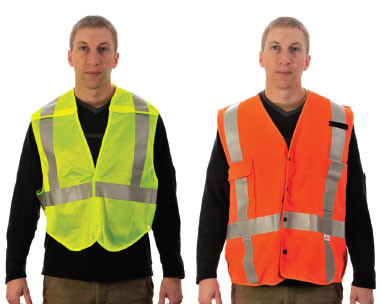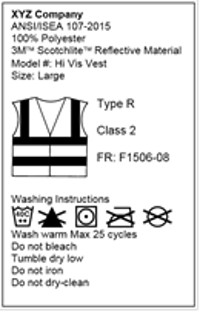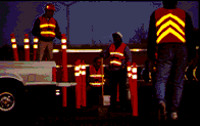High Visibility Safety Apparel
Edited by Frank Brewer (Source: https://www.osha.gov/SLTC/personalprotectiveequipment)
Personal protective equipment, commonly referred to as “PPE”, is equipment worn to minimize exposure to hazards that cause serious workplace injuries and illnesses. These injuries and illnesses may result from contact with chemical, radiological, physical, electrical, mechanical, or other workplace hazards. Personal protective equipment may include items such as gloves, safety glasses and shoes, earplugs or muffs, hard hats, respirators, coveralls, vests and full body suits. For those who work in the transportation industry, the first form of PPE to come to mind is generally High-Visibility Safety Apparel (HVSA). HVSA garments are commonly referred to as the “safety vests”. However, that is actually only one type.


What is HVSA?
HVSA standards are set by the American National Standards Institute, or ANSI, in its American National Standard for High-Visibility Safety Apparel and Accessories (ANSI/ISEA 107-2015). ANSI/ISEA 107 is a regulatory requirement for most transportation workers due to its inclusion by reference in the 2009 Edition of the Manual on Uniform Traffic Control Devices (MUTCD). Section 6D.03, Paragraph 04 of the MUTCD states:



The minimum acceptable garment for these workers is Class 2. It is referred to as the “safety vest” as it sleeveless. Class 3 garments are recommended for higher speed roadways (greater than 50 mph) or during nighttime operations. Regardless of the size of a garment, a Class 3 garment must have sleeves.
Class 2 and Class 3 garments must have specific background colors, specific retroreflective colors, and specific minimum surface area for retroreflective material. There are several retroreflective patterns and colors available. The approved background colors currently are: fluorescent yellow-green, fluorescent orange-red, or fluorescent red. For within the right-of-way use the Class 2 or Class 3 compliant HVSA garment may be a mesh Over-garment style, Tear-away, Tee-shirt style, Polo style shirt, Button-up style shirt, or Foul Weather garment. Also available are garments with reduced specifications to fit the smaller frame worker.
All HVSA garments must carry a label indicating ANSIISEA compliance. This label indicates which ANSI-ISEA standard applies, the performance Class of garment, its photometric performance level, and includes washing instructions. The garments will get dirty, they do not have to stay dirty. The washing life statement is a guideline. During successive washings, the retroflective material may breakdown. Garments that are soiled or torn to the point they no longer function as designed need to be replaced.
The purpose of HVSA is to make the wearer visible to the road users, in all types of light levels and different weather conditions. Worker visibility is enhanced by providing high contrast between the garment and the ambient background against which it is seen. Additionally the garment should provide 360° of visible coverage. Should only the mesh over-garment style be used, it should be large enough to fit over the workers foul weather gear. If the road user can see you early enough they should have the time and opportunity to avoid hitting you. During nighttime operations the Class 2 garment is visible up to 1,000 feet from the light source (the road user's vehicle head lights); the Class 3 garment provides visibility out to 1,280 feet.
Why should I wear HVSA?
You are special. You work in a very hazardous environment. You are very fragile in comparison to a vehicle or heavy equipment. What may seem like an uncomfortable inconvenience is designed to protect you. Safety glasses protect your eyes from flying objects. Hard hats protect you from overhead hazards or falling objects. HVSA allows drivers and coworkers to see you as a person, not as a piece of equipment or a traffic control device. Many of these road users do not expect to see workers alongside or within the roadway. They do not understand the danger that their speed poses to you or how long it would take to stop their vehicles. The earlier they see you, the more time they will have to adjust their speed or maneuver their vehicle. The road users deserve to go home after their work day. You also deserve to go home at the end of your work day! Using HVSA greatly increases that probability. If you have any questions regarding PPE in general or HVSA in particular, please contact me at 865-974-8251 or fbrewer1@utk.edu.
Back-Contents-Forward